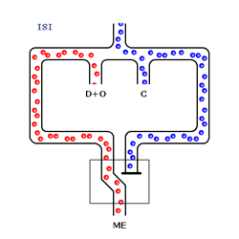
Apparatuur
Olfactometer
A 8-channel olfactometer for accurate and controlled administration of odours to participant. This instrument can be used in combination with our 3T MRI for functional MRI studies.
Principle
An olfactometer is a machine designed to deliver odours in a precisely-controlled manner, for instance in order to objectively assess olfactory function (‘ability to smell’) in a participant. This olfactometer provides a constant flow of air via a small tube to the nose of the participant. The air flow is heated to body temperature and humidified to > 60% relative humidity to prevent any thermal irritation and ensure that the nasal mucosa does not dry out.
The Burghart olfactometer works according to the Kobal switching principle. In this switching principle – schematically depicted below -, all flows are conveyed to the switching device: control (non-odorous air), dilution (non-odorous air) and odorant (odorous air).

During the inter-stimulus interval, the mixture of odorant and dilution is removed by means of a vacuum flow, and only the control flow reaches the participant’s nose.
During stimulation, it is the control flow that is removed by means of a vacuum flow, and the mixture of odorant and dilution air flows into the participant’s nose.
Technical details
Burghart olfactometer including:
- Up to eight odorants in liquid or gaseous form
- Integrated pressure and vacuum supply
- Bi-rhinal mode possible
- Computer-controlled air flows
- Reproducible pain stimuli by using CO2
- Water-heated system for stability of temperature
- Certified as a class IIa medical device according to 93/42/EC.
Applications
Burghart olfactometers are suitable to use for behavioural odour studies, electroencephalography (EEG) and functional MRI.
This olfactometer allows for application of rectangular-shaped chemical stimuli, which are necessary for the recording of event-related potentials (ERP) by means of EEG (electroencephalography). There are no magnetic valves and magnetic materials in the head of the olfactometer which could influence EEG recordings or fMRI testing.
Publications
- Human protein status modulates brain reward responses to food cues. Am J Clin Nutr. 2014 May 21.
- Severity of olfactory deficits is reflected in functional brain networks—An fMRI study. Human Brain Mapping. May 2018.
- Aroma effects on food choice task behavior and brain responses to bakery food product cues. Food Quality and Preference. September 2018.
- Zoon HFA, de Bruijn SEM, Smeets PAM, de Graaf C, Janssen IMC, Schijns W, Aarts EO, Jager G, Boesveldt S. Altered neural responsivity to food cues in relation to food preferences, but not appetite-related hormone concentrations after RYGB-surgery. Behav Brain Res. 2018 Nov 1;353:194-202.
In addition, Wageningen University & Research, Shared Research Facilities offers the use of:
